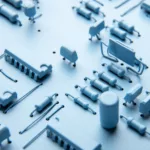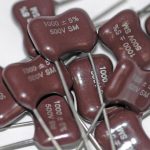
Introduction
Baluns––short for “balanced to unbalanced,” are essential components in many RF (radio frequency), microwave and antenna engineering systems. They serve as the bridging components with the crucial functionality of transforming signals between balanced and unbalanced modes, making them vital in numerous applications such as television receivers, radio transmitters, and antenna systems. This article explains the different types of balun and the practical performance parameters that engineers must consider when designing and using these devices.
Introduction to Baluns: Exploring Their Significance
Baluns are versatile electrical or electronic devices engineered to alter between balanced and unbalanced electrical signals. These devices are significant in RF (called RF Balun) and microwave systems, where impedance matching and signal transformation are fundamental requirements. Baluns can connect balanced transmission lines, such as twisted pairs or differential traces, to unbalanced transmission lines, like coaxial cables––minimising signal loss and maintaining signal integrity. Baluns, for instance, in balun circuit design, ensure that signals can pass seamlessly between these two modes without causing unwanted reflections or distortion.
Popular Types of Baluns – Unlocking Their Broad Range Varieties
Baluns come in several standard types, each designed for specific applications and operating principles. Some of the most common types of balun include:
Transformer Baluns
Transformer baluns are among the most common types of balun that consist of a transformer with a primary winding––connecting to the balanced transmission line and a secondary winding––connecting to the unbalanced transmission line. Transformer baluns work on the principle of magnetic coupling. When an AC signal is applied to the primary winding, it induces a voltage in the secondary winding. The turn ratio of the windings determines the impedance transformation between the balanced and unbalanced sides.
Transmission Line Baluns
Transmission line baluns use a section of the transmission line (often coaxial cable or microstrip) to transform between balanced and unbalanced modes. The key to their operation lies in the characteristic impedance of the transmission line. By carefully designing the length and impedance of the line, engineers can create a balun effect. Transmission line baluns are particularly useful for broadband applications. However, they can be challenging to design accurately, as the required dimensions depend on the operating frequency.
Hybrid or 4-port Baluns
Hybrid or 4-port baluns consist of four ports––two balanced and two unbalanced and are more complex than transformer and transmission line baluns. They can provide impedance transformation and phase and amplitude control, making them suitable for applications where precise control over signal balance and phase is required, such as in antenna arrays and phased-array radar systems.
Integrated Circuit (IC) Baluns
With advancements in semiconductor technology, IC baluns have become increasingly popular. These baluns are fabricated on a single integrated circuit and offer a compact and cost-effective solution for many applications. IC baluns can be found in consumer electronics, wireless communication devices, and more. IC baluns come in various forms, including differential amplifiers, active baluns, and passive baluns, each tailored to specific requirements.
Practical Performance Parameters of Baluns – Basic Selection Criteria
When selecting or designing a balun for a particular application, engineers must consider various applicable performance parameters, such as environmental considerations and physical constraints, to ensure optimal system performance. Some of the essential parameters include:
- Impedance Matching – To minimise signal reflections, it is critical to achieve good impedance matching between the balanced and unbalanced sides of the balun. A well-matched balun ensures the signal is efficiently transferred without loss or distortion.
- Power Handling Capability – The power handling ability of a balun determines the maximum power levels the balun can handle without distortion or damage. It is essential to choose a balun with the ability to control the power levels expected in your application.
- Frequency Range – Different baluns are designed for specific frequency ranges; therefore, choose one that matches the intended operating frequency of your system.
- Insertion Loss – Insertion loss represents the amount of signal power lost as it passes through the balun. Lower insertion loss is generally preferable, especially in high-frequency applications where signal integrity is critical.
- Common Mode Rejection Ratio (CMRR) – CMRR is a measure of a balun’s ability to reject common mode noise––a noise that appears identically on both lines of a balanced signal.
- Return Loss – Return loss quantifies the amount of signal power reflected back to the source due to impedance mismatches. A lower return loss indicates better performance, as it signifies that less signal is reflected.
- Isolation – Isolation is the degree to which the balanced and unbalanced ports of the balun are isolated from each other. High isolation prevents unwanted coupling between the ports and minimises interference.
- Phase and Amplitude Balance – In some applications, maintaining precise phase and amplitude balance between the balanced and unbalanced ports is essential. This is especially crucial in phased-array antennas and other beamforming systems.
- Size and Form Factor – The physical size and form factor of the balun is a crucial consideration, particularly in compact or space-constrained systems. IC baluns often excel in this regard due to their small footprint.
Final Thoughts
Baluns are indispensable components in RF and microwave systems––enabling the seamless transfer of signals between balanced and unbalanced transmission lines. Understanding the various types of balun and their practical performance parameters is essential for engineers to make informed decisions when designing and integrating them into their systems. Whether working on a high-frequency communication system or a compact consumer electronics device, choosing the suitable balun and optimising its performance can significantly impact your system’s overall performance and reliability.





















